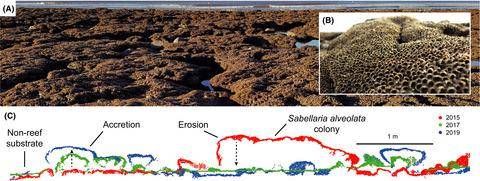当前位置:
X-MOL 学术
›
Remote Sens. Ecol. Conserv.
›
论文详情
Our official English website, www.x-mol.net, welcomes your feedback! (Note: you will need to create a separate account there.)
Three-dimensional mapping reveals scale-dependent dynamics in biogenic reef habitat structure
Remote Sensing in Ecology and Conservation ( IF 5.5 ) Pub Date : 2021-05-15 , DOI: 10.1002/rse2.213 Tim Jackson‐Bué 1 , Gareth J. Williams 1 , Guy Walker‐Springett 1 , Steven J. Rowlands 1 , Andrew J. Davies 2 , Vincent Lecours
Remote Sensing in Ecology and Conservation ( IF 5.5 ) Pub Date : 2021-05-15 , DOI: 10.1002/rse2.213 Tim Jackson‐Bué 1 , Gareth J. Williams 1 , Guy Walker‐Springett 1 , Steven J. Rowlands 1 , Andrew J. Davies 2 , Vincent Lecours
Affiliation

|
Habitat structure influences a broad range of ecological interactions and ecosystem functions across biomes. To understand and effectively manage dynamic ecosystems, we need detailed information about habitat properties and how they vary across spatial and temporal scales. Measuring and monitoring variation in three-dimensional (3D) habitat structure has traditionally been challenging, despite recognition of its importance to ecological processes. Modern 3D mapping technologies present opportunities to characterize spatial and temporal variation in habitat structure at a range of ecologically relevant scales. Biogenic reefs are structurally complex and dynamic habitats, in which structure has a pivotal influence on ecosystem biodiversity, function and resilience. For the first time, we characterized spatial and temporal dynamics in the 3D structure of intertidal Sabellaria alveolata biogenic reef across scales. We used drone-derived structure-from-motion photogrammetry and terrestrial laser scanning to characterize reef structural variation at mm-to-cm resolutions at a habitat scale (~35 000 m2) over 1 year, and at a plot scale (2500 m2) over 5 years (2014–2019, 6-month intervals). We found that most of the variation in reef emergence above the substrate, accretion rate and erosion rate was explained by a combination of systematic trends with shore height and positive spatial autocorrelation up to the scale of colonies (1.5 m) or small patches (up to 4 m). We identified previously undocumented temporal patterns in intertidal S. alveolata reef accretion and erosion, specifically groups of rapidly accreting, short-lived colonies and slow-accreting, long-lived colonies. We showed that these highly dynamic colony-scale structural changes compensate for each other, resulting in seemingly stable reef habitat structure over larger spatial and temporal scales. These patterns could only be detected with the use of modern 3D mapping technologies, demonstrating their potential to enhance our understanding of ecosystem dynamics across scales.
中文翻译:

三维映射揭示了生物礁栖息地结构的尺度依赖动态
栖息地结构影响生物群落中广泛的生态相互作用和生态系统功能。为了理解和有效管理动态生态系统,我们需要有关栖息地属性的详细信息,以及它们如何在空间和时间尺度上变化。测量和监测三维 (3D) 栖息地结构的变化历来具有挑战性,尽管人们认识到其对生态过程的重要性。现代 3D 制图技术提供了在一系列生态相关尺度上表征栖息地结构的空间和时间变化的机会。生物礁是结构复杂且动态的栖息地,其中结构对生态系统的生物多样性、功能和恢复力具有关键影响。首次,跨尺度的Sabellaria alveolata生物礁。我们使用无人机衍生的结构运动摄影测量和地面激光扫描来表征1 年内栖息地尺度(~35 000 m 2 )和地块尺度(2500 m)的毫米到厘米分辨率的珊瑚礁结构变化2 ) 5 年以上(2014-2019 年,每 6 个月一次)。我们发现,基质上方珊瑚礁出现、吸积率和侵蚀率的大部分变化是由系统趋势与海岸高度和高达殖民地规模(1.5 m)或小斑块(高达4 米)。我们在潮间带S. alveolata中发现了以前未记录的时间模式珊瑚礁的增生和侵蚀,特别是快速增生的短寿命群落和缓慢增生的长寿命群落。我们表明,这些高度动态的群体规模结构变化相互补偿,导致在更大的空间和时间尺度上看似稳定的珊瑚礁栖息地结构。这些模式只能通过使用现代 3D 制图技术才能检测到,这表明它们具有增强我们对跨尺度生态系统动态理解的潜力。
更新日期:2021-05-15
中文翻译:

三维映射揭示了生物礁栖息地结构的尺度依赖动态
栖息地结构影响生物群落中广泛的生态相互作用和生态系统功能。为了理解和有效管理动态生态系统,我们需要有关栖息地属性的详细信息,以及它们如何在空间和时间尺度上变化。测量和监测三维 (3D) 栖息地结构的变化历来具有挑战性,尽管人们认识到其对生态过程的重要性。现代 3D 制图技术提供了在一系列生态相关尺度上表征栖息地结构的空间和时间变化的机会。生物礁是结构复杂且动态的栖息地,其中结构对生态系统的生物多样性、功能和恢复力具有关键影响。首次,跨尺度的Sabellaria alveolata生物礁。我们使用无人机衍生的结构运动摄影测量和地面激光扫描来表征1 年内栖息地尺度(~35 000 m 2 )和地块尺度(2500 m)的毫米到厘米分辨率的珊瑚礁结构变化2 ) 5 年以上(2014-2019 年,每 6 个月一次)。我们发现,基质上方珊瑚礁出现、吸积率和侵蚀率的大部分变化是由系统趋势与海岸高度和高达殖民地规模(1.5 m)或小斑块(高达4 米)。我们在潮间带S. alveolata中发现了以前未记录的时间模式珊瑚礁的增生和侵蚀,特别是快速增生的短寿命群落和缓慢增生的长寿命群落。我们表明,这些高度动态的群体规模结构变化相互补偿,导致在更大的空间和时间尺度上看似稳定的珊瑚礁栖息地结构。这些模式只能通过使用现代 3D 制图技术才能检测到,这表明它们具有增强我们对跨尺度生态系统动态理解的潜力。



























 京公网安备 11010802027423号
京公网安备 11010802027423号